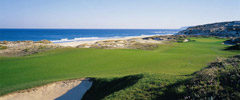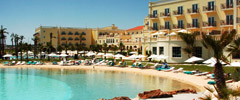Golf in Porto
Porto is a busy industrial and commercial center. The city itself isn't very populous (about 240,000 inhabitants), but the Porto metropolitan area (Big Porto) ranks some 1,500,000 inhabitants in a 50 km radius, with cities like Gaia, Matosinhos, Maia, Gondomar and Espinho.
The city was built along the hills overlooking the Douro river estuary, and its historical center was awarded World Heritage status by UNESCO in 1996. It has been continuously inhabited since at least the 4th Century, when the Romans referred to it as Portus Calle
Porto has a semi-Mediterranean climate, although it's strongly affected by the Atlantic ocean, which makes it cooler than other Mediterranean cities. However, temperatures can rise as high as 40ºC in August during occasional heat waves. Winters are mild and humid, with occasional cold nights where temperatures can drop below 0ºC.
Porto has always been a mercantile city, and this is evident in the style of buildings that front onto the Avenida dos Aliados, the core of the downtown area. The center of town, unlike other major Portuguese cities, which tend towards the baroque, is granite and monumental. Residents of Porto are known as Tripeiros (tripe eaters) allegedly due to the fact that the city went without meat in order to provision the the fleet that left to conquer Ceuta in North Africa in 1415 (which left from Porto) and had to subsist on tripe soup, still a specialty of the city.
Citizens of Porto, while definitely Portuguese, hold themselves apart culturally from the rest of the country, as is expressed in the often heard phrase "o Porto é uma nação" (Porto is a nation). Outsiders often consider Porto to be more crass and mercantile than the rest of the country, and less lacking in social graces. This is likely due to the fact that the city has historically been dominated by Portuguese bourgeoisie and English trading factions rather than the nobility. Tripeiros of course, disagree, regarding themselves (with some justification) as being the economic heart of the nation. As the saying goes, "Porto works, Braga Prays, Coimbra studies, and Lisbon gets the money."
The city is officially styled "a muito nobre, sempre leal e invicta cidade do Porto" (the very noble, always faithful, and invincible city of Porto). This is usually lengthened to "a Cidade Invicta" (the invincible city) a title won because of Porto's unparalleled resistance against Napoleonic troops during the Peninsular war.
The city is quite variegated architecturally, with medieval as well as modern living side by side. Porto's geography is hard on the feet, but pleasant to the eye. The city is extremely hilly, with many buildings built into a cliff face that overlooks the river. Stairs cut into the stone run up and down the cliff face and offer a laborious but rewarding walking tour. Across the river from Porto proper, in the suburb of Gaia, are located the warehouses of notable companies dealing with Port Wine, such as Cálem, Fonseca, Sandemans, Kopke, and others.
If you're looking for a golfing break in Porto, you can find a varied style of landscape from one course to another, but you have to be prepared to travel some miles to get from one to another. Here's a list of golf courses in Porto: Club Golf Miramar, Curia Golf Club, Estela Golf Club, Golfe da Quinta do Fojo, Golfe de Amarante, Montebelo Golfe, Oporto Golf Club, Ponte de Lima, Quinta da Barca, Vale Pisão and Vidago Palace Golf.




